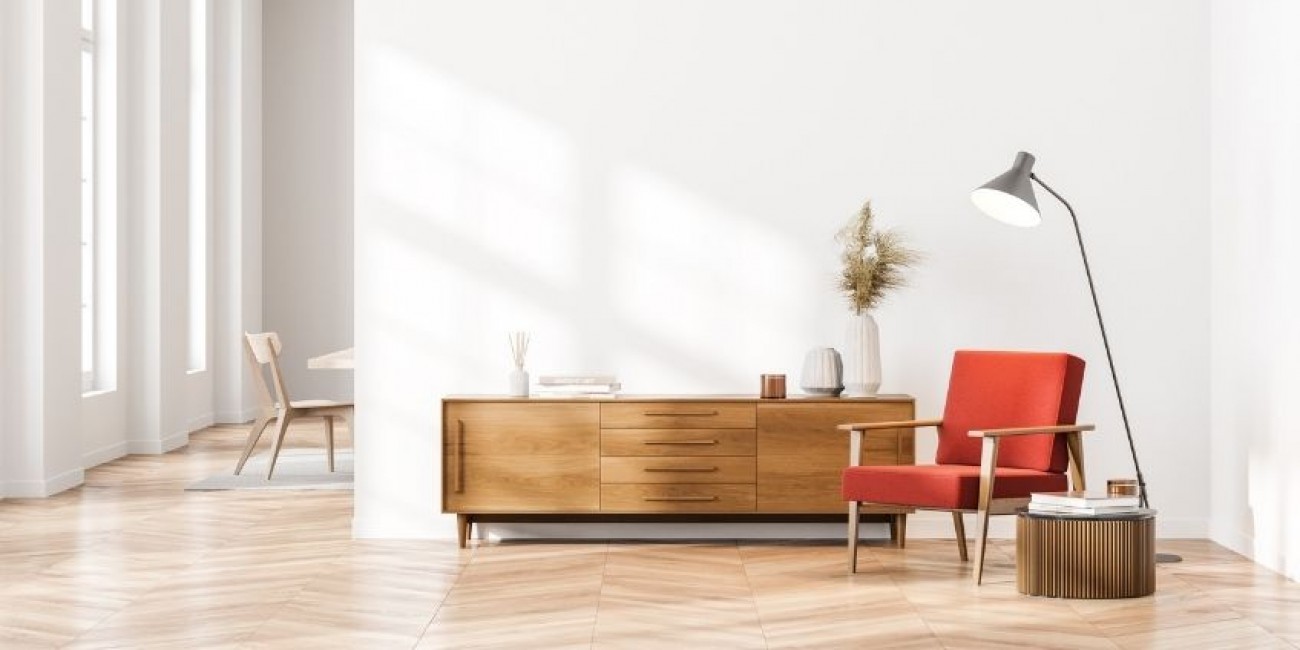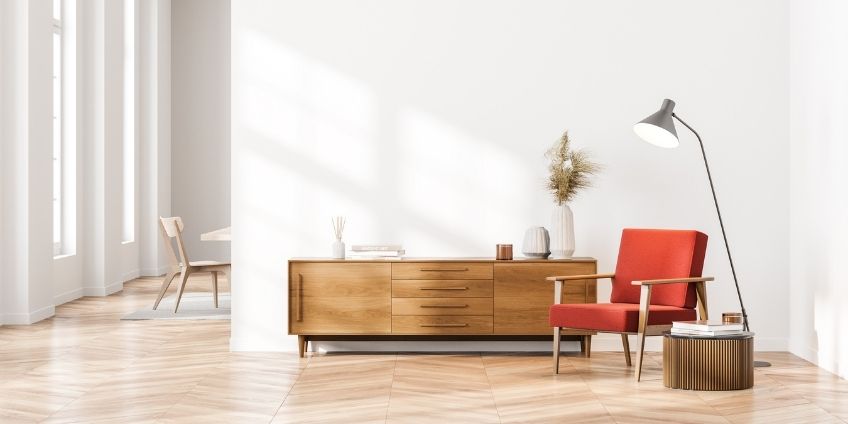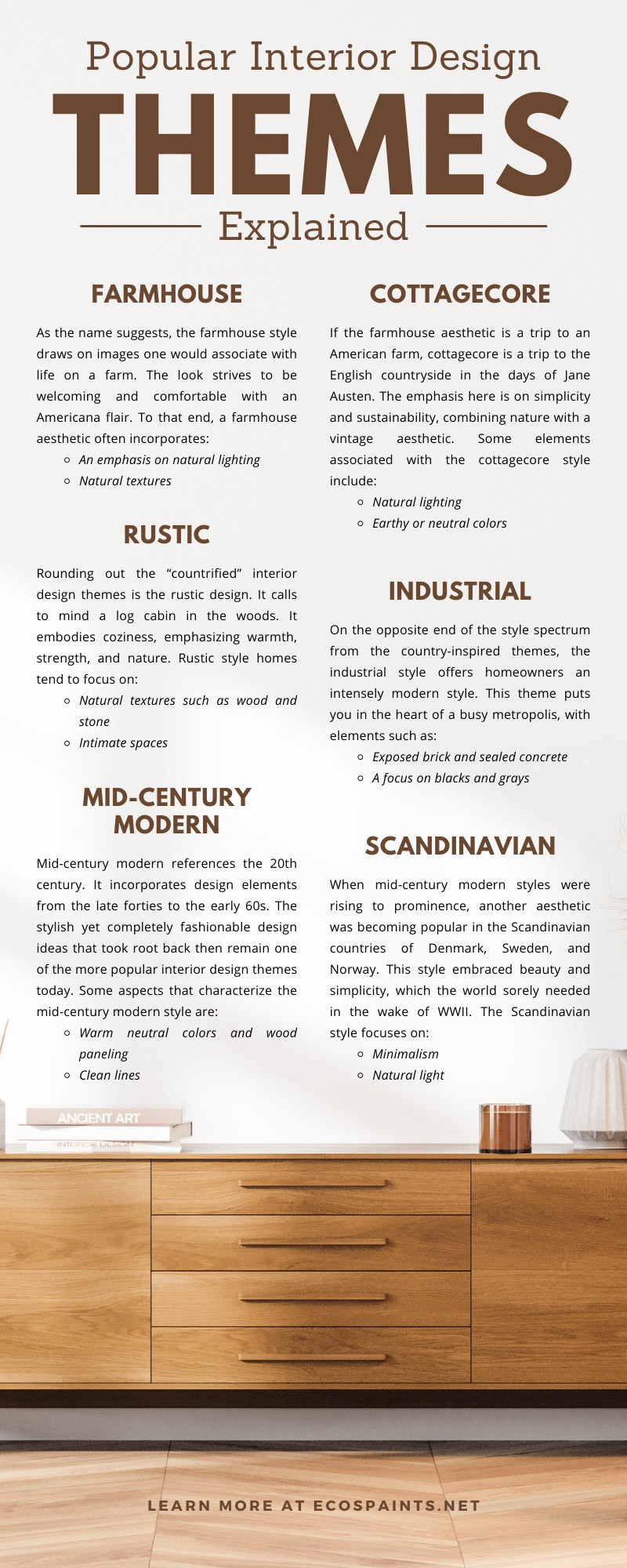Popular Interior Design Themes Explained


A new home or apartment is like a blank canvas. Four blank walls offer a profusion of potential designs. Will you create a colorful Pollock? An eclectic Picasso? Or a cozy Rockwell?
However, having so many options can make deciding on a room design overwhelming. Fortunately, plenty of interior designers have gone before you and left artistic footprints for you to follow. Those footprints are interior design themes. To help you start your artistic journey, we’ve explained the popular interior design themes.
Farmhouse
As the name suggests, the farmhouse style draws on images one would associate with life on a farm. The look strives to be welcoming and comfortable with an Americana flair. To that end, a farmhouse aesthetic often incorporates:
- An emphasis on natural lighting
- Natural textures
- Wooden flooring or architectural elements.
- Traditional furniture
- Vintage and antique pieces
- Farm-inspired accessories, such as farmer’s market signs or milk canisters.
The farmhouse aesthetic can be more blatant with more traditional elements, such as gingham and knit fabrics and more farm-inspired accessories. Or it can be introduced subtly, intermingling with more modern elements.
Cottagecore
If the farmhouse aesthetic is a trip to an American farm, cottagecore is a trip to the English countryside in the days of Jane Austen. The emphasis here is on simplicity and sustainability, combining nature with a vintage aesthetic. Some elements associated with the cottagecore style include:
- Natural lighting
- Earthy or neutral colors
- Nature elements such as floral patterns or potted plants
- Knit textures such as throw pillows
- Distressed furniture
- Vintage or antique pieces
Cottagecore tends to emphasize an old-fashioned flair more than the farmhouse style, but it’s still possible to combine both modern and old-fashioned elements. For instance, you can use more modern furniture pieces but create a wallpaper accent wall.
Rustic
Rounding out the “countrified” interior design themes is the rustic design. It calls to mind a log cabin in the woods. It embodies coziness, emphasizing warmth, strength, and nature. Rustic style homes tend to focus on:
- Natural textures such as wood and stone
- Intimate spaces
- Warm lighting
- Darker colors
- Wooden and traditional furniture
- Accessories that bring the woods to mind (for example moose antlers, snowshoes, or art of the mountains.)
Rustic themes also exist on a modern to traditional spectrum. More traditional rustic homes seek to model a cabin in the woods. Others tend to add more modern furniture and open flooring elements to call to mind a luxury ski lodge.
Industrial
On the opposite end of the style spectrum from the country-inspired themes, the industrial style offers homeowners an intensely modern style. This theme puts you in the heart of a busy metropolis, with elements such as:
- Exposed brick and sealed concrete
- A focus on blacks and grays
- Clean, modern lines
- Open floor plans
- Modern, metal lighting fixtures (especially with Edison bulbs)
- Metal piping, wiring, and accessories
Industrial is the design theme least reminiscent of the country. Even so, some designers use this to their advantage to add unexpected country elements such as weathered wood.
Mid-Century Modern
Mid-century modern references the 20th century. It incorporates design elements from the late forties to the early 60s. The stylish yet completely fashionable design ideas that took root back then remain one of the more popular interior design themes today. Some aspects that characterize the mid-century modern style are:
- Warm, neutral colors and wood paneling
- Clean lines
- Open floorplans
- Well-crafted furniture pieces
- Modern pendant light fixtures
- Framed wall art and prints
Even though the style is over sixty years old, a mid-century modern theme is a good choice for those who desire a contemporary and crowd-pleasing room design.
Scandinavian
When mid-century modern styles were rising to prominence, another aesthetic was becoming popular in the Scandinavian countries of Denmark, Sweden, and Norway. This style embraced beauty and simplicity, which the world sorely needed in the wake of WWII. The Scandinavian style focuses on:
- Minimalism
- Natural light
- Neutral colors, especially whites
- Muted accents in blues and greens
- Light-colored wood
- Plush, natural textiles
The biggest design takeaway from the Scandinavian style is the emphasis on a light, airy space. Less is more when it comes to furniture and other accessories, although having a few intentional art pieces is acceptable.
Art Deco
Art deco rose to prominence in the 1920s after Paris’ International Exhibition of Modern Decorative and Industrial Arts. To this day, it still calls to mind the lavish style of the decade and cultural symbols such as The Great Gatsby. To incorporate art deco into our modern interiors, focus on:
- Metallic surfaces such as glass, silver, and gold
- Bold colors, especially jewel tones
- Furniture with curved bodies and straight legs
- Geometric patterns
- Art deco-inspired artwork
Because art deco is such a distinctive style, it tends not to be mixed with other styles. But because it’s so bold, you can often incorporate other more eclectic elements seamlessly, such as animal print.
Boho
When someone refers to someone as a “bohemian,” one immediately imagines a free-spirited artist. The same applies to a room that’s designed with a boho theme in mind. Some design principles that capture the boho theme include:
- A combination of bright colors and neutrals
- Combining multiple patterns
- Emphasizing textiles such as rugs, throws, and mats
- Eclectic and handmade accessories and furniture
- Incorporating art pieces
- Houseplants
The emphasis of the boho theme is on creative expression, which, as a rule, doesn’t focus on hard and fast rules. The idea is to create a space where you feel free and comfortable.
Wabi-Sabi
Wabi-sabi is a philosophy that originated in Japan in the 15th century. The principle focuses on finding beauty in imperfections instead of in materialistic perfectionism. When applied to design, you create a space that focuses on authenticity and comfort. Some wabi-sabi design elements include:
- Neutral colors
- Natural materials such as wood and stone with a rough finish
- Natural textiles
- Minimalist
- Mismatched furniture
Remember, the focus here is on finding beauty in the imperfections. Like the boho theme, the point isn’t to stick to hard and fast rules but to find beauty in your space however it looks. This is often applied to a Japanese-inspired aesthetic, but the principle can be applied to any theme.
Whether you’re creating a cozy cottagecore living room or a loud art deco den, we want to make sure you have everything you need to create a design theme that’s a work of art. That’s why we have interior eggshell paint in every color under the sun to turn your home into a masterpiece.



























